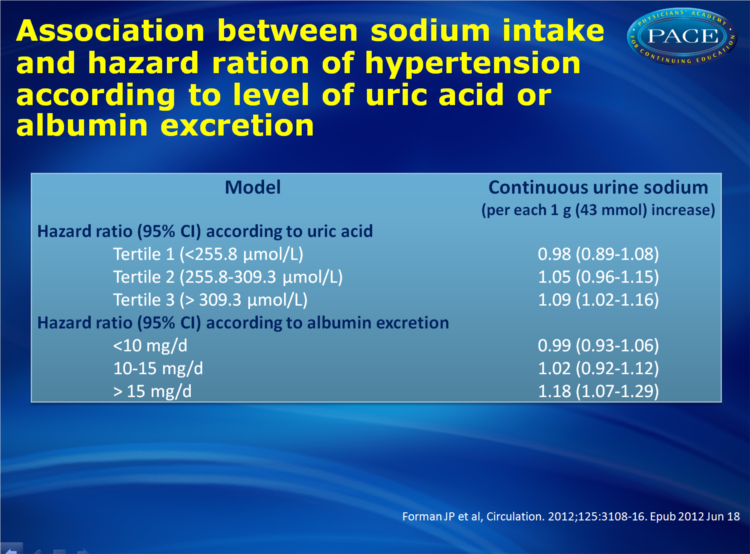Sodium intake: a risk factor for endothelial dysfunction and hypertension
A higher sodium intake might be positively associated with a longitudinal increase in SUA and UAE, which might modify the association between sodium intake and hypertension. This was tested in participants of the PREVEND study (Prevention of Renal and Vascular End Stage Disease).
Association between sodium intake and change in uric Acid, urine albumin excretion, and the risk of developing hypertension.Literature - Forman JP et al, Circulation. 2012;125:3108-16. Epub 2012 Jun 18
Forman JP, Scheven L, de Jong PE, Bakker SJ, Curhan GC, Gansevoort RT.
Circulation. 2012;125:3108-16. Epub 2012 Jun 18.
Background
While short-term sodium loading does not substantially increase blood pressure [1,2], long-term high sodium intake is associated with increases in blood pressure over time in healthy humans [3,4]. The reasons for this are not well understood. Short-term sodium load is associated with endothelial dysfunction and vascular injury [4]. Over the long term this could explain hypertension associated with a chronically high-salt diet.Higher serum uric acid (SUA) and a higher urinary albumin excretion (UAE) are markers of endothelial dysfunction and independently associated with an increased risk of hypertension.
A higher sodium intake might be positively associated with a longitudinal increase in SUA and UAE, which might modify the association between sodium intake and hypertension. This was tested in participants of the PREVEND study (Prevention of Renal and Vascular End Stage Disease).
Main results
- A higher sodium intake caused an increase in SUA and UAE.
- The adjusted hazard ratio for developing hypertension was 0.98 (95% CI, 0.89-1.08) for the lowest tertile of SUA and 1.09 (1.02-1.16) for the highest tertile for each 1g- higher sodium intake.
- The adjusted hazard ratio for developing hypertension was 0.99 (95% CI, 0.93-1.06) for the lowest tertile of UAE and 1.18 (95% CI 1.07-1.29) for the highest tertile for each 1g- higher sodium intake.
Click on image to enlarge: See left column to download as PowerPoint
Conclusion
A high sodium intake over a longer term may lead to endothelial dysfunction and vascular damage, resulting in an increased risk for developing hypertension.
References
1. Institutes of Medicine. A Population-Based Policy and Systems Change Approach to Prevent and Control Hypertension. http://www.iom.edu/ Reports/2010/A-Population-Based-Policy-and-Systems-Change-Approachto-Prevent-and-Control-Hypertension.aspx. Accessed July 2011.2. Carlstrom M, Sallstrom J, Skott O, et al. Uninephrectomy in young age or chronic salt loading causes salt-sensitive hypertension in adult rats. Hypertension. 2007;49:1342–1350.
3. Chien KL, Hsu HC, Chen PC, et al. Urinary sodium and potassium excretion and risk of hypertension in Chinese: report from a community-based cohort study in Taiwan. J Hypertens. 2008;26:1750 –1756.
4. He FJ, MacGregor GA. Effect of longer-term modest salt reduction on blood pressure. Cochrane Database Syst Rev. 2004:CD004937.
Abstract
Background:A high-sodium diet has little short-term effect on blood pressure in nonhypertensive individuals but, for unclear reasons, is associated with hypertension if consumed long term. We hypothesized that a chronically high sodium intake would be associated with increases in biomarkers of endothelial dysfunction, specifically serum uric acid (SUA) and urine albumin excretion (UAE), and that high sodium intake would be associated with incident hypertension among those with higher SUA and UAE.
Methods and results:
We prospectively analyzed the associations between sodium intake and the change in SUA (n=4062) and UAE (n=4146) among participants of the Prevention of Renal and Vascular End Stage Disease (PREVEND) study who were not taking antihypertensive medications. We also examined the association of sodium intake with the incidence of hypertension (n=5556) among nonhypertensive participants. After adjustment for confounders, each 1-g-higher sodium intake was associated with a 1.2-μmol/L increase in SUA (P=0.01) and a 4.6-mg/d increase in UAE (P<0.001). The relation between sodium intake and incident hypertension varied according to SUA and UAE. For each 1-g-higher sodium intake, the adjusted hazard ratio for developing hypertension was 0.98 (95% confidence interval, 0.89-1.08) among those in the lowest tertile of SUA and 1.09 (1.02-1.16) among those in the highest tertile. Corresponding hazard ratios were 0.99 (confidence interval, 0.93-1.06) among participants whose UAE was <10 mg/d and 1.18 (confidence interval, 1.07-1.29) among those whose UAE was >15 mg/d.
Conclusions:
Over time, higher sodium intake is associated with increases in SUA and UAE. Among individuals with higher SUA and urine UAE, a higher sodium intake is an independent risk factor for developing hypertension.

